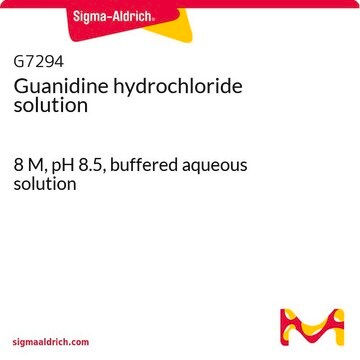SRE0066
Guanidine hydrochloride solution, 6M
Synonym(s):
Aminoformamidine hydrochloride, GuHCl, Guanidinium chloride, Guanidium chloride
About This Item
Recommended Products
form
liquid
Quality Level
concentration
6 M
application(s)
diagnostic assay manufacturing
storage temp.
room temp
Related Categories
Application
Guanidine hydrochloride has also typically been used for the isolation of RNA, to denature globular proteins, and for protein refolding studies. It can also be used to facilitate the generation of tryptic peptides for analysis of complex protein samples.
Physical form
Note: If precipitation is present in the 6 M buffer, warm the bottle to 37 °C and mix until completely dissolved prior to use.
Signal Word
Warning
Hazard Statements
Precautionary Statements
Hazard Classifications
Acute Tox. 4 Oral - Eye Irrit. 2 - Skin Irrit. 2
Storage Class Code
10 - Combustible liquids
WGK
WGK 1
Flash Point(F)
Not applicable
Flash Point(C)
Not applicable
Certificates of Analysis (COA)
Search for Certificates of Analysis (COA) by entering the products Lot/Batch Number. Lot and Batch Numbers can be found on a product’s label following the words ‘Lot’ or ‘Batch’.
Already Own This Product?
Find documentation for the products that you have recently purchased in the Document Library.
Customers Also Viewed
Articles
A RPLC-MS workflow for mass analysis of reduced monoclonal antibody, trastuzumab, including reduction procedures, calibration, and system suitability tests.
A complete reversed phase HPLC-ELSD workflow, including sample preparation for the analysis of Polysorbate 80 in a monoclonal antibody formulation.
A RPLC-MS workflow for mass analysis of non-reduced monoclonal antibody, trastuzumab, including calibration, and system suitability tests.
Protocols
SEC-MS protocol for rapid glycoprofiling of monoclonal antibodies with antibody purification and mass spectrometer calibration.
A complete workflow for the intact and middle-up mass analysis of reduced and non-reduced monoclonal antibodies based on SEC-MS with sample preparation by protein-A affinity clean-up.
Our team of scientists has experience in all areas of research including Life Science, Material Science, Chemical Synthesis, Chromatography, Analytical and many others.
Contact Technical Service




